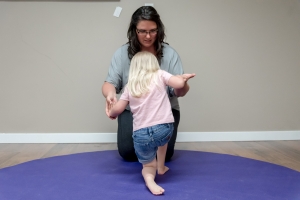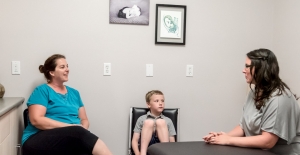Bed wetting can be an extremely frustrating problem to have, for kids and their parents. Why does it happen? What might be causing it? How can physio help?
Pediatric pelvic health physiotherapy is an integral part of the care team for children that are experiencing persistent bed wetting aka nocturnal enuresis. Many children go through daytime potty learning, and just seem to never really quite get the night-time down pat. For others, they breeze through daytime and night-time dryness, and then at some point the night-time problems start and just get worse over time. If you are struggling with potty learning check out our blog.
So why does bed wetting happen?

Bed wetting can in some instances simply be a result of a deep sleeper and an immature bladder. These are kids that will eventually just grow out of it. Many children, however, fit into the “underlying contributing factors” category. Our ability to be continent (hold our urine) at night can be impacted by a number of factors. Here we will go through two main issues:
- Constipation
- Daytime urinary dysfunction
Constipation
Often times we think of constipation as children going days on end without bowel movements, having extreme difficulty evacuating the bowel, tears, and an overall dramatic experience (which definitely may be the case). BUT some of the time constipation looks like multiple bowel movements a day, quick trips to the washroom, and stool being evacuated without having an actual sensation of the “I need to poop”
The question is how does constipation impact bed wetting? During appointments we take the time to sit down and draw out the relationship (clients get signed copies to take home because the artistic talent is top notch!) – but imagine that the bladder is a balloon, and the abdomen is like a Tupperware container. If the bowel is a long skinny balloon that also fits into the container there is only a certain amount of space in there. When we start to stuff the bowel with some extra stool, it will take up more space in the container. This will leave less space for the bladder, and it will get squished before it can send a signal of “I’m full go pee!” resulting in bed wetting. Biggest take away?
Really the child has no signal that they need to go!

Daytime Urinary Dysfunction
When a parent comes with their child for an appointment and the only reason is “bed wetting” there is a good chance that it isn’t JUST bed wetting. In order for the problem to be strictly nocturnal enuresis, it needs to be present in the absence of any daytime abnormalities. Many children that come in have several daytime issues going on, and often the parents don’t even realize it! Here are a few things that often come up during discussions with children:
- decreased urinary frequency during the day (<4x/day)
- increased urinary frequency during the day (>7x/day)
- leaking urine during the day
- altered sensation to void (not sensing the urge to go, or having the urge and being unable to go)
- voiding difficulties (feeling the urge to go and not being able to)
We struggle especially with school aged children as we often don’t know what their bathroom habits are! Our society tends to significantly limit our bathroom involvement with our kids after they have potty learned, even though they may need parent support until age 5 to ensure they are building positive bowel and bladder hygiene routines!
If you have a child that is holding their bladder all day, you can imagine that might impact night-time dryness. If they are having any sort of daytime dysfunction, the night-time wetting will have difficulty resolving independently, since our kids are sleeping (hopefully!) at night, the greatest impact we can have on bed wetting is by working on the daytime dysfunction and/or constipation!
Ultimately, bed-wetting in many instances is not something that the child is wanting to do or has control over (despite what many of our friends and relatives will tell us). If you have a child that is wetting at night at any age, it may be worth it to think about some of these factors. When in doubt, give us a shout!
Book an assessment for your child!






